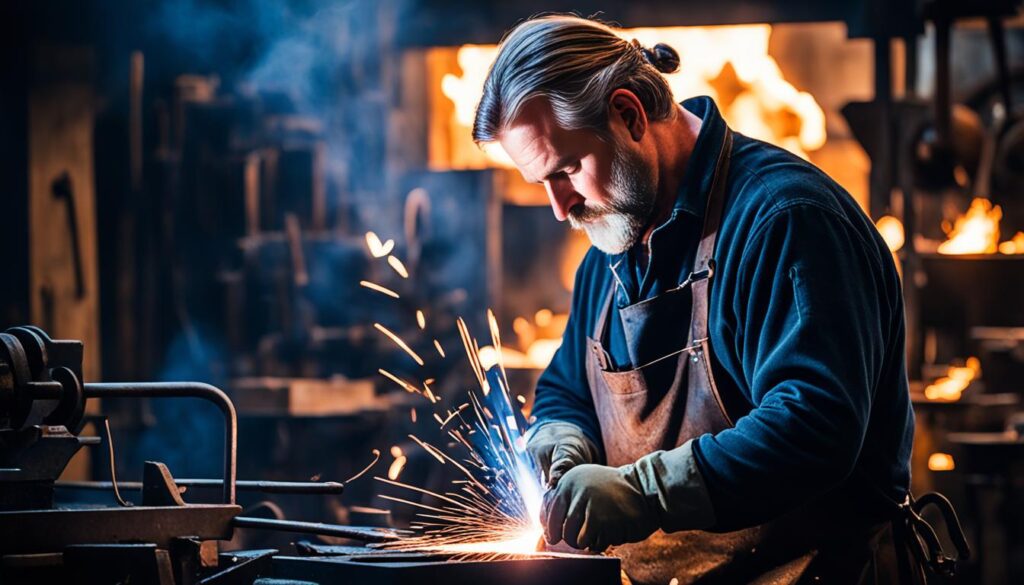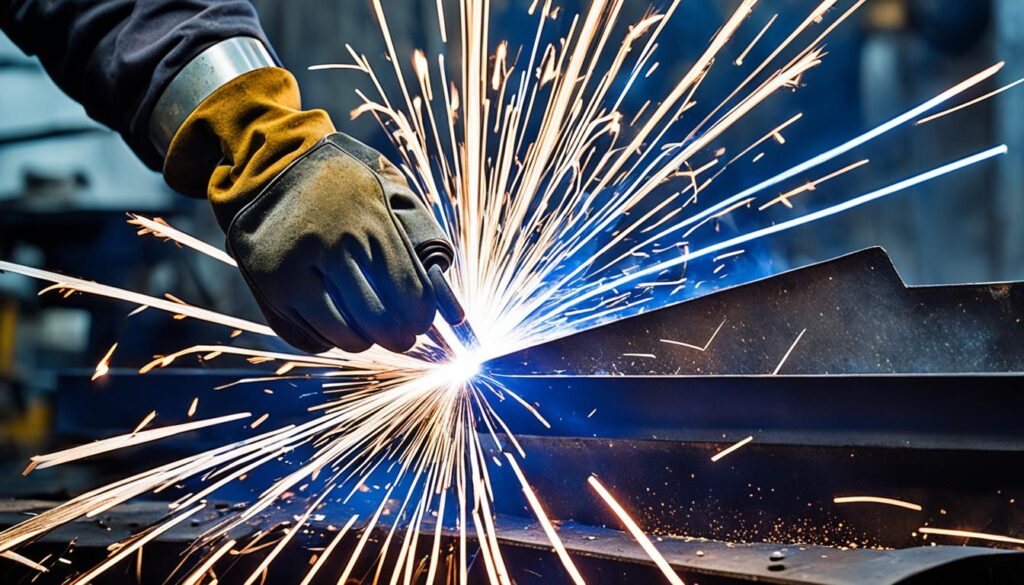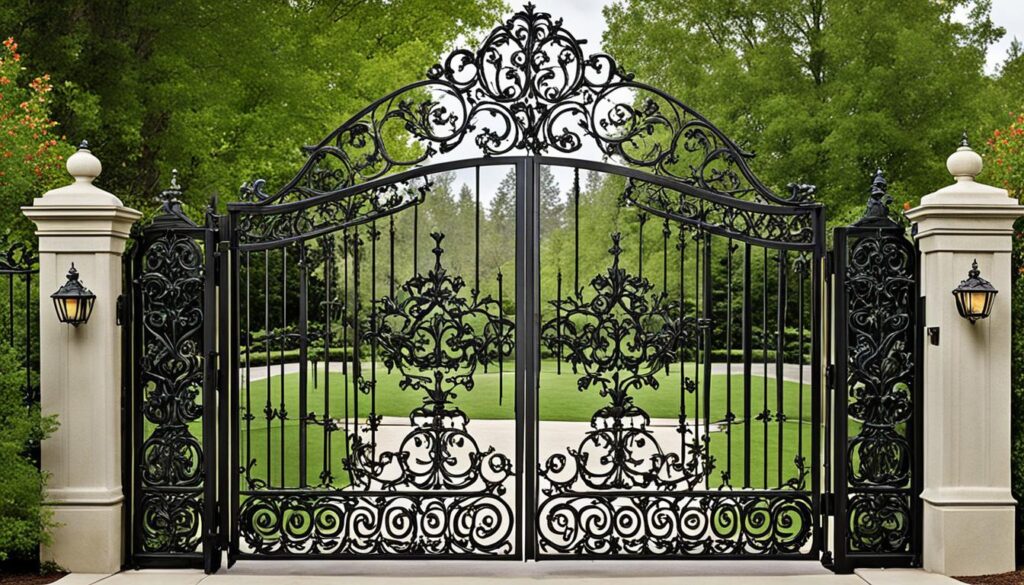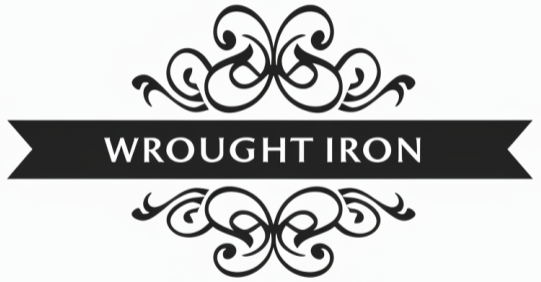
Ever looked at an old wrought iron gate and wondered how it was made? Maybe you have a wrought iron fence that needs fixing, or you’re into making wrought iron pieces. Welding wrought iron might seem hard, but with the right skills, you can make these pieces look new again. It’s important to know how this metal works and its challenges before you start.
Key Takeaways
- Wrought iron’s low carbon and sulfur content makes it easy to weld, showing it’s well-made1.
- Using the right welding methods, like manual or shielded metal arc welding, helps make strong welds1.
- Don’t weld too deeply to avoid getting slag in your welds1.
- Make sure to remove all lead-based paints to prevent breathing in lead fumes1.
- For repairs or strengthening wrought iron, talk to experts to ensure safety and strength1.
Understanding Wrought Iron Welding
Welding wrought iron is key for making fences, gates, and furniture. It’s different from other irons because it needs special welding methods. These methods use rutile-coated electrodes that meet certain standards1. Also, MAG welding filler wires with aluminum, silicon, and manganese help make strong welds1.
Preheating and post-heating are important steps when welding wrought iron. This helps deal with its high carbon content, which can make welds brittle2. Doing this makes your welds last longer and keeps the structure strong.
Choosing the right welding materials is crucial when working with wrought iron. Stainless steel wire is sometimes used as a cheaper option instead of nickel rods2. But, be careful, as it can make the repair very brittle2. Nickel-based electrodes are better because they help prevent cracking and keep the carbon low2
Sometimes, brazing is better than welding for fixing cast iron, especially when working with wrought iron3. The quality of the wrought iron affects how well it welds. Keeping it low in carbon and sulfur, and making sure the slag is evenly spread, helps avoid welding issues1. Proper handling also reduces the chance of big slag inclusions, making the weld stronger1. Knowing how to weld wrought iron is key for successful projects.
It’s a good idea to preheat when welding cast iron items like old pieces to prevent damage2. This approach is backed by many who have tried it and seen good results3. Knowing the difference between wrought iron and cast iron is also important, as they need different welding methods3.
Here’s a table that shows the welding materials and methods for wrought iron:
| Material/Technique | Details |
|---|---|
| Rutile-Coated Electrodes | Comply with BS EN 499 E38 X R XX or AWS E6013 for MMA welding1 |
| MAG Filler Wires | Contain aluminum, silicon, and manganese to offset high oxygen content1 |
| Nickel-Based Electrodes | Recommended for reducing cracking and maintaining low carbon content2 |
| Preheating & Post-Heating | Essential for mitigating high carbon content’s impact on welds2 |
| Brazing | Preferred over welding for avoiding brittleness in cast iron repairs3 |
Challenges and Techniques in Wrought Iron Welding
Welding wrought iron comes with its own set of challenges because of its unique make-up. It’s important to know these challenges well to get good results. This knowledge helps in managing the welding process better.
The Nature of Wrought Iron
Wrought iron is known for being tough, easy to shape, and resistant to corrosion. It’s great for many projects. But, it can be tricky to weld because of impurities and slag in its layers4. It also has a high melting point, making it harder to work with4. Because it’s mostly pure and doesn’t have much carbon, special welding and forging methods are needed4.

Common Welding Techniques
There are different welding methods for wrought iron, each designed to overcome its welding challenges. Manual Metal Arc Welding and MAG welding with certain filler wires are common1. OxyeAcetylene Welding and Braze Welding are also good options. It’s important to test welding procedures to match wrought iron’s varied properties1. This helps control the quality of the weld.
Choosing the Right Equipment
Choosing the right tools is key for successful wrought iron projects. Alloys with lots of manganese work best for old wrought iron5. Using stringer beads, preparing the weld area less, back-stepping, and cooling between welds can help reduce stress in the metal1. Impurities like silica can affect welding success a lot5; so, it’s important to watch closely during welding4.
Knowing these details helps you tackle the challenges of wrought iron welding. This ensures your finished product is both strong and looks good.
Can You Weld Wrought Iron? Yes, Here’s How
Welding wrought iron requires knowing its unique features and choosing the right methods. This alloy is different from mild steel ornamental ironwork, which stopped being made in the 1970s6. To answer the question, *can you weld wrought iron*, it’s key to know it’s flexible, strong, ductile, and resistant to corrosion4. Despite being hard to work with, its strength and durability make it valuable for certain projects7
Welding wrought iron uses methods like forge welding, which is best for its properties, and gas welding (oxy-acetylene), which is also popular6. Many ask, can you weld wrought iron for decorative items? Yes, you can, using techniques like MIG, TIG, and stick welding6. Each method has its own details; TIG welding takes longer but looks great, while MIG welding is good for clean welds6.
When *repairing wrought iron*, some tips can make the welds better and last longer. Using ER-70 wire with a 75/25 mix, applying anti-spatter spray, wire wheel brushing, and proper grinding helps6. Also, clean surfaces and the right pre-heat temperature are key to avoid stress cracking and ensure strong repairs.
- Forge welding: Best for compatibility
- Gas welding (oxy-acetylene): Commonly used
- MIG welding: Clean beads for ornamental work
- TIG welding: Time-consuming, visually pleasing
Welding *wrought iron* needs skill and practice for good welds6. Its semi-laminar structure and higher melting point than carbon steel mean you must watch closely while welding4. With the right skills, knowledge, and tools, you can fix wrought iron well, even for decorative pieces like balusters and fences. Regular upkeep, like cleaning and repainting, can also make your iron fence last longer7.
Expert Tips for Successful Wrought Iron Projects
For wrought iron projects to succeed, pay close attention to cleaning, choosing welding rods, and what to do after welding.
Proper Cleaning and Preparation
Clean the wrought iron surfaces well before welding. This removes dirt that could affect the weld quality. It’s also key to preheat the iron to stop moisture problems, which helps wrought iron gates and fencing last longer.

Use of Proper Welding Rods
Choosing the right welding rods is crucial for your wrought iron projects. Nickel rods are a top choice for their flexibility and ease of working with8. They create welds that are strong and good for detailed work on wrought iron furniture and more8. Even though 99% nickel rods cost more, they give the best results for precise projects9.
Post-Welding Considerations
After welding, make sure to clean the weld area well for a neat finish. This is especially true if you’re going to paint your wrought iron pieces. A clean weld surface means better paint adhesion, leading to a long-lasting finish for gates, fencing, and furniture. Also, let the weld cool down slowly to avoid cracks or changes in shape, which keeps your work strong10.
Conclusion
To wrap up, mastering wrought iron welding means following the best practices. It’s key to know that wrought iron has very little carbon, between 0.02% and 0.05%. This knowledge helps in getting the best results11. Choosing the right welding methods, like arc welding with special rods, leads to strong and accurate results12.
Using the correct tools, such as AC stick welding machines and Henrob gas welders, is vital. Also, making sure the surface is clean and pre-heating it are important steps12. After welding, treating the metal right and handling it carefully can make the joints last longer and stronger.
By being careful in the welding process and after, you can make wrought iron structures that last a long time. Using these expert tips in your work means your projects will be top-notch. It also keeps the classic beauty of wrought iron alive in today’s world.
FAQ
Can you weld wrought iron effectively?
What are common welding techniques for wrought iron?
How should you prepare wrought iron for welding?
What are the challenges in welding wrought iron?
What type of welding rods should be used for wrought iron?
How do you ensure a strong and durable join in wrought iron fabrication?
Can wrought iron be repaired through welding?
What post-welding considerations should be taken for wrought iron projects?
Source Links
- Can wrought iron be repaired by welding? – https://www.twi-global.com/technical-knowledge/faqs/faq-can-wrought-iron-be-repaired-by-welding
- Welding Wrought Iron – https://app.aws.org/forum/topic_show.pl?tid=3840
- stick welding wrought iron railing – https://weldingweb.com/vbb/threads/262311-stick-welding-wrought-iron-railing
- Welding wrought iron | Model Engineer & Model Engineers Workshop – https://www.model-engineer.co.uk/forums/topic/welding-wrought-iron/
- Welding Steel to Wrought Iron – https://app.aws.org/forum/topic_show.pl?tid=25339
- Welding Wrought Iron – https://weldingweb.com/vbb/threads/18541-Welding-Wrought-Iron
- Wrought Iron Fence Repair – Let Our Pros Help You Out – https://bravofencecompany.com/wrought-iron-fence-repair-let-our-pros-help-you-out/
- Can You Weld Cast Iron? (A Complete Guide) – https://www.twi-global.com/technical-knowledge/faqs/can-you-weld-cast-iron
- Can You Weld Cast Iron to Steel? A Comprehensive Guide – https://www.arccaptain.com/blogs/article/can-you-weld-cast-iron-to-steel
- How to Successfully Weld Cast Iron – https://tooliom.com/blogs/tooliom/how-to-successfully-weld-cast-iron
- Wrought Iron – an overview – https://www.sciencedirect.com/topics/engineering/wrought-iron
- welding cast iron heads – The BangShift.com Forums – https://bangshift.com/forum/forum/bangshift/tech-section/1333-welding-cast-iron-heads




